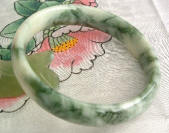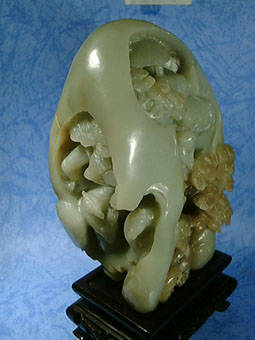 |
The word "jade"
communicates a sense of mystery. In Chinese, "jade" (yu) refers to a fine,
beautiful stone with a warm color and rich luster, that is skillfully and
delicately carved. In Chinese culture, jade symbolizes nobility, perfection,
constancy, and immortality. For millennia, jade has been an intimate part of the
lives of Chinese of all ranks and classes. It is viewed as the most valuable of
all precious stones.

Jade is found in mountains and riverbeds,
and Chinese consider jade to be "the essence of heaven and earth." When polished
and carved into various articles, jade is attributed with certain cultural
characteristics. In ancient Chinese cosmology, the firmament was considered to
be round, and the earth square. Thus a round jade ceremonial ornament with a
hole in the center, called a pi, was carved to honor the gods of heaven, and a
long hollow jade ornament with rectangular sides, called a ts'ung, was made to
honor the spirits of earth. According to ancient Chinese legend, the phoenix and
the dragon are animal deities that were the life-source of family clans. For
this reason, jade was often used as a material for carving phoenixes and dragons
worn as ornaments. These ornaments symbolized the noble bearing of a gentleman,
and are the origin of the Chinese saying : "The gentleman's morals are like
jade."
Sacrificial and auspicious articles were
used in ancient institutionalized rites, and are generally referred to as
"ritual utensils." Sacrificial utensils were used in offerings to ancestors or
in paying ceremonial respect to the gods of heaven and earth. We know from
archaeological remains that people of the Neolithic Era carved a great number of
round pi and rectangular ts'ung for use as sacrificial utensils. The concept of
a round heaven and rectangular earth, which eventually became deeply ingrained
in the Chinese mind, may have first emerged around this time. "Auspicious
utensils" were carried or worn by the nobility as symbols of their office or
authority. For example, jade axes and spades later evolved into kuei, elongated
pointed tablets of jade. When the "son of heaven," or emperor, dispatched a
duke, prince, or other official for external duty, he would give him a "tablet
of authority" to proclaim the task assigned to him by the "son of heaven." The
traditional function of ritual jade utensils gradually began to wane after the
Han Dynasty (206 B.C. to 220 A.D.), when only a small number of sacrificial jade
utensils were used in ceremonial rites led by the emperor.

Burying jade objects with the
dead was a common practice in ancient China.
"The living wear jade as a
symbol of their moral integrity, and jade accompanies the deceased to comfort
their souls." Over four thousand years ago in China, great quantities of jade
utensils were often laid over or around a casket, particularly the
pi-representing the round heaven, and the ts'ung signifying the rectangular
earth. They were a symbolic link of communication between heaven and earth, of
exchange between man and the spiritual world. Later, jade articles were carved
specifically for burial with the dead, based on the idea that the jade's
qualities of nobility, perfection, constancy, and immortality would prevent the
physical body from decay. Examples of jade objects for burial use are a thin,
light jade cicada which was placed in the mouth of the dead, and a thick, round
jade piglet, which was enclosed in a hand of the deceased. A cicada goes under
the ground and is "reborn" after shedding its skin; and a pig breeds quickly,
thus increasing wealth. Thus natural motifs are used to express human desires
for reincarnation or increased wealth for one's family.
The development of jade utensils after the
Sung (960-1279 A.D.) and Yuan (1271-1368 A.D.) dynasties tended more towards
pure craftsmanship and artistry. Except for a small number of ritual jade
utensils set out by the emperor in sacrificial rites, the carving of large
quantities of jade utensils in this era is attributable mainly to their
sophisticated aesthetic appeal. The majority of carved jade items were ornamental in nature, including pieces for
display and items for personal use. But ornamental jade display pieces were also
used for reasons. Such articles included brush holders, brush washers, water
cups, armrests, and red ink paste (for name chops) boxes. Fine and exquisite
workmanship endowed each piece with richness, luster, and delicacy, reflecting
the high quality of life aspired to by the Chinese. Jade items for personal use
included combs, hairpins, bracelets, and waist pendants. Jade ornaments were
also set in walking sticks, waist sashes, garments, and caps.
majority of carved jade items were ornamental in nature, including pieces for
display and items for personal use. But ornamental jade display pieces were also
used for reasons. Such articles included brush holders, brush washers, water
cups, armrests, and red ink paste (for name chops) boxes. Fine and exquisite
workmanship endowed each piece with richness, luster, and delicacy, reflecting
the high quality of life aspired to by the Chinese. Jade items for personal use
included combs, hairpins, bracelets, and waist pendants. Jade ornaments were
also set in walking sticks, waist sashes, garments, and caps.
Jade ornaments have remained popular up
until the present day. Today in the Taiwan, the purchase, wearing, and giving of
jade items as gifts is still very common. Jade is viewed as an ideal gift for
couples making a mutual commitment, and for one's children when they get
married. Even now, the Chinese retain the idea that in addition to being
beautiful, jade can protect from misfortune and bring good luck.
Jade is an essence produced through the
natural forces of rivers and mountains over eons. However, if it is not
skillfully cut and polished, there is no way for the potential richness and
luster that people prize to be expressed. The Chinese have a saying that goes.
"If jade is not properly cut, it cannot be made into a useful utensil." Cutting
is an important step in the process of producing jade articles.
The manufacture of Chinese jade articles
was already highly developed by the Shang Dynasty (16th to 11th century B.C).
The Chinese of this period had the technology to produce jade articles of every
imaginable type, shape, and size. By the end of the Chou Dynasty (11th century
to 256 B.C.) and the beginning of the Han Dynasty, Chinese jades reached a
second peak in their development. Craftsmen had at their disposal more advanced
tools and efficient methods of polishing jade and creating unsurpassed
masterpieces. One technique involved carving an article with several linked
components out of a single piece of jade, demonstrating the high sophistication
of the craftsman's mastery. From this point on, jade craftsmen could accommodate
practically any and every customer demand in their work.
In the Taiwan today, the art of jade
carving has reached yet another summit in its development. Traditional forms and
modern styles are combined into striking new creations, and modern technology
has greatly elevated the quality of workmanship. No longer is jade for the
exclusive use of emperors and noblemen; just about everyone in the Taiwan has
the means to own and wear jade. Beyond maintaining its historical role, jade
artistry has been further developed with creativity and skill, and has become an
indispensable part of everyday life. Jade remains an eternal symbol of China's
magnificent civilization.
Advertisement
|
 |

